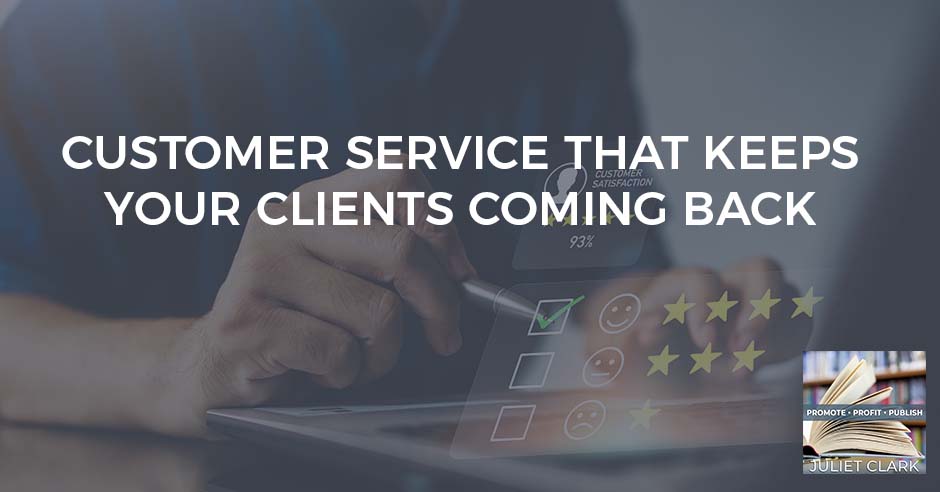
In this competitive world, you can find several companies or platforms that offer the same product at almost the same cost. The difference comes down to customer experience. In this episode, Wall Street Journal and New York Times #1 bestselling author and certified customer experience professional, Joseph Michelli talks about what makes extraordinary customer service, what drives customer satisfaction and how building relationships with your customers and understanding their journey is crucial to building trust in your brand and making them feel supported from the time they purchased your product to assistance they may need after.
Want to learn more? Follow Joseph Michelli on Linkedin for his weekly newsletter.
—
Watch the episode here
Listen to the podcast here
Customer Service That Keeps Your Clients Coming Back
In this episode, we have a guest that’s a little bit different. You are going to know some good nuggets of information. Before we get started, don’t forget to go over to YouTube if you’re a video person and subscribe to Superbrand Publishing. All of these interviews and some of our training are over there so you can get a lot of information. Also, go to Breakthrough Author Magazine and get your free copy.
I want to tell you something about this free copy of Breakthrough Author Magazine. If you subscribe, we get it delivered to your inbox every month. The only solicitation you are ever going to get from us in there is we will let you know when we are having online events over on LinkedIn. That’s it. We don’t solicit sales or any solicitation here. This is something where we offer free magazine and free training for you. You can get that at www.BreakthroughAuthorMagazine.com.
Since COVID hit, I have seen so much go wrong in the customer service world. Joseph Michelli, PhD is a certified customer experience professional and the author of ten business books about companies like the Ritz-Carlton Hotel Company, Mercedes-Benz, Starbucks, Zappos and Airbnb. In addition to being the Wall Street Journal and New York Times’ number one bestselling author, Joseph helps leaders and frontline team members improve the experiences they provide to colleagues and customers.
Joseph also is an internationally sought-after keynote speaker on leadership and human experience design. Why is this important to us in the book world? For most of us, our book is a nurturing tool for our business. Joseph has some great nuggets in this interview about what you need to post so that you’re not selling all the time. Also, that big transition you have to make from being a thought leader on social media to getting those people on your list. I hope you enjoy this. It’s a fabulous interview. He was an amazing guest.
—
Welcome, Joseph. We are excited to have you here. I serve a lot of small businesses, coaches, authors and speakers. Customer service is not always at the top of their list. They’re more worried about the day-to-day running of their company but it does make a big difference. I’m glad to have you. You have a new book out that covers this. Do you want to talk a little bit about that?
My latest book is called Stronger Through Adversity, which is looking at how you deal with this crazy time that we’ve come through. How have customers changed? What do we need to be doing to bring all of the operational excellence that people do worry about every single day alongside some humanistic things that ensure that people feel cared about?
That’s the reason I was so interested in talking to you. I’ve had so many experiences and my clients talk about it as well. We’re connected with big companies where we have problems and we don’t feel cared for at all. Let’s dive into, first of all, seeing a lot of companies with AI.
What happened during the pandemic is we relied on technology to allow us to stay connected to our customers. We couldn’t do it face to face. Technology roadmaps have maybe AI five years down the road bringing it on full force. People were able to bring it on in 5 or 6 weeks out of necessity. You’re seeing the use of an understanding of big data to anticipate ways to provide service to people. The success is dependent upon not only the AI but having people to warm up all of those suggestions.
I ran into a situation with Verizon where I got caught in a big loop. When I finally got ahold of somebody three weeks later, she said, “I hear you. I got caught in the same loop when I had a problem with my company. I have elevated how frustrating this is.” That was great that somebody got caught in their loop.
Technology is what a lot of people want to opt into. But when something goes wrong with the technology, you need to have a competent, warm, caring, human being available to make it work. Share on XUnfortunately, it wasn’t so great that the loop kept on for three weeks. If you’re in a loop, you want ready access to a human being who can pull you out of the loop. Often, you don’t get looped and the technology as a service option works well. We have to understand that technology for a lot of people is what they want to opt into. When something goes wrong with the technology, you need to have a competent, warm and caring human being available to make it work.
Here’s the other thing I see a lot and it’s been going on for a while. It’s outsourced off-shore where you’re connected with someone. I had something happen with my accounting and I won’t say who it is but it’s a big one out there. They have people from another country. I have a very complex tax problem and am being serviced by someone from another country who I couldn’t understand. I was so very frustrated. What is the deal with that? Are we seeing a lot of companies diving into that more?
It’s gone both ways. There were big trends years ago to offshore all kinds of customer service. There were lots of pushbacks from people who said language meditation is an issue. “I don’t have the ability to communicate with people. They may be less expensive for you but they’re not better for me as a consumer.” There has been seemingly a shift back towards virtual assistants that are on the rise globally. Use virtual assistants as part of the customer service equation but you have to realize that customers are not satisfied with customer service.
The American Customer Satisfaction Index has us at a seventeen-year low. Between not being able to find people to do the work here and efforts to try to support that with global support staff and having the kinds of challenges you have between products not getting to where they need to be and not having people positioned to do it is a mess.
If you are going to set up a great customer service system that made people feel supported and valued, what would the ingredients of that be?

Customer Service: It really is an opportunity to invite customers into a relationship with you to celebrate and appreciate the moments that they took with you.
It starts with you as the leader. You have to first identify what you want every customer to feel every single time they interact with your brand, whether they interact with you through your people or technologies. You have to define that. What is our desired outcome of every interaction emotionally for the person you’re serving? Once you’ve defined that, then you have to decide where are the moments we can have the greatest impact on delivering that.
You shouldn’t try to handle every single touch point because most of us can’t ensure that every single touch point is nailed but certain points are of higher value than others. We know what that is from behavioral economics. It’s the arrival moments, the transition moments, the peak moments, the pain modes and the departure moments. If you understand those, look at the journey of your customers as they arrive, either on your website or via a phone call or if you’re in a face-to-face environment, understand how to own that.
The moment they get there, they feel they belong and are welcomed. There’s excitement about their arrival. Make sure you understand where they transitioned during their journey and where it is that you can help them not feel like they’re going to get lost in a gap between sales and service or whatever it might be. Make sure you own the ending.
Don’t let people go and say, “Thanks for your business. I got your money. See you later.” It is an opportunity to invite them into a relationship with you, to celebrate and appreciate the moments that they took with you. If you focus on those things, know what you want people to feel and get the key moments in their journey, you’ll be very successful and sustainable in customer experiences delivered. Sometimes it will be through self-service. Sometimes it’ll be through humans.
One of the things that happen with authors and small business people is that they go into, “We find a lot with our authors.” They don’t understand their customers. Would you agree that you have to have a thorough understanding? That is a prelude to the outcomes that those types of people are looking for.
Always visualize who your customer is. Share on XAs an author, sometimes when I’m writing, I don’t understand my customer. I have to always visualize who my customer is. In my world, it’s two people. It’s a small business owner. Normally, I think of a person who’s running a dry cleaner in Poughkeepsie. I’m also thinking of someone who’s in the customer experience business or an organization trying to drive that business. First, I have to understand that. It then relates to how I get to that reader or if I am trying it to an audience that might want me to speak about my book. What does that audience need?
It is a deep understanding of the drivers for those people. What’s going to make their life better? Why would they want to interact with me? What can I do to contribute to life and ease them as they’re doing their job? All of those things are critical. It takes me stepping out of my shoes, where I want to sell something, to get into their shoes to understand what are they needing and how they need me to deliver it to make their life easier and better.
From an author, we talk about this a lot with the author platform building. What did you dive into to understand that customer and make all of this work?
I’m so off the grid on some of these things. I’ve been around for so long and I got incredibly in some of my early books. My first book was about the Pike Place Fish Market. There was a prior book written that was incredibly successful. Our job is to try to follow that parade. Where did that book succeed? Who got value out of it? How was it as a sequel that wasn’t a knockoff but added some unique insights beyond what was available?
For me, it was studying the success of that prior book and who it resonated with. From that, we did a lot of surveying. We looked at our analytics on where the book sold and we positioned the next book about Starbucks with a similar audience. Suddenly, we found that it was appealing to audiences beyond what we envisioned. We started to think, “What was going on with that audience? How could we tap into that for our next book?” It was constantly trying to understand who was gathering around whatever we were putting out.

Customer Service: If you just focus on the customer’s journey and know what you want people to feel when they hit the key moments in their journey, you’ll be very successful and very sustainable.
Once we knew that market, then we could build products in the future that would support them. We had lots of conversations with the buyers. We would set focus groups up and I would volunteer to do book clubs, which was a big thing for me. Have time to say, “What is it you didn’t like about the book? What was it that you wished hadn’t been in there? What was it that stuck with you?” That shaped the way I decided how to create content in the future.
That is amazing information. You’ll probably get a good giggle out of this. I’m assuming you did your focus groups online. Is that a poor assumption?
As much as we could. It was online but not in a virtual meeting. It was more like email exchanges with people who purchased the book for some incentive.
Back when I worked at Shy Day in the late ‘80s or early ‘90s, we were the people that would approach you at a mall and ask you to come into a backroom. When I hear focus group and I think about that, I’m like, “Somebody would have you arrested if you do that.”
I remember those days. The market research was being done in malls and you would pull people in for some quick little research study.
Click and gone is not really what you want. You want the lifetime value of a customer. Share on XWe used to have them into lots of M&M’s, diet Cokes and movie reels. The movie studios did it to not move the rails but add rails like, “What is your impression of all these?” I’m so glad that it’s moved online. Those were fun though.
Doing customer intercepts in the mall to try to get applied research. It’s exciting but there’s not even that much mall traffic anymore, probably.
I don’t know how you’d ever do it but back then, we didn’t have the electronic visibility that we have now. When you took a deep dive into these books, what was the thing that the people said they got the most out of?
It’s whenever I asked them to take the knowledge back to themselves. In every book I write, there is a striking gold to applying the standards to yourself. You write the content and then say, “This is how Starbucks did it. In your world, what is it that you’re doing the customer walks?” Starbucks says this concept of the customer walk where they have one barista per shift responsible for going out in the parking lot and walking the path of the customer looking at what the customer sees, seeing the pastry case from the customer side of the interaction.
You teach that lesson and tell the story of how Starbucks does it and why they do it. You say, “How might you take that concept and help everyone on your team become the eyes and ears of customers?” That question is what has been super important to my readers in the sense that, “Many Starbucks does that,” but forced me to internalize that learning and come up with a way to translate it into the way I do business.

Customer Service: Understand what your customers need and how they need you to deliver it to make their life easier and better.
I have a funny story about Starbucks right after I left Shy Day. I was interviewed by the venture capital of the company. I remember sitting in the interview and telling me they were going to put a coffee shop on every corner. I don’t drink coffee so I was like, “I don’t get it.” I did not get the job either.
Surprising to say that when Starbucks was in that mode, more people own private jets than they did espresso machines in the US. The whole concept of drinking espresso-based coffee was not in our psyche. It was transformative to create a community place where people could have a conversation over a cup of coffee. That’s what it did. It created a third place between work and home for a lot of people in the beverage, as opposed to a bar. The beverage was coffee.
I didn’t get it back then. I’m not the visionary I think I am.
You probably saved a lot of money over your life not getting it unless you did invest in the stock.
I probably did. What are some big takeaways that if you were working with my clients, you would start with the basics that they have to rebuild being online entrepreneurs? One of the things that happen out there is people get caught up in the funnels and they don’t understand that a click is not a relationship. How would you work with those people and suggest that they build those great relationships that will lead to those higher ticket items?
It's always easier to sell more to somebody who said yes once than it is to ever sell to anybody who's never said yes. Share on XIt’s always great to get people clicking and buying your stuff. That’s wonderful but clicking gone is not what you probably want. You want the lifetime value of a customer. You have to understand some customers need nurturance and don’t move through your funnel quickly. What can I do to continue to nurture and groom people who may not initially fall in love with you to the point of pushing the button to buy your product?
Those campaigns where you’re providing quality and thought leadership in the absence of them purchasing to keep them engaged are important. Beyond nurturing that non-buyer, once somebody has clicked, that is a special thing. They have done something that most people don’t do. They have already entrusted you with the product. That should be the starting point. It’s always easier to sell more to somebody who said yes once than it is to ever to anybody who’s never said yes.
Once somebody has clicked, they’re in this special thing. They’re not a buyer that I can churn and burn on. They’re a person that I want to be ready for. My products come out every other year from a book perspective. I need to maintain a relationship with people for two years so I don’t fall out a minute before the next book drops. I can’t be pitching my book the whole time for two years. I need to start providing thought content to them. Radically, I need to reach out to them with events and ideas and share ideas with other people. I’m a trusted advisor in my area.
The more we conceptualize our role as navigating and building relationships, sales follow-up. The more we try to push a sale, the more we have to do that all the time. It’s like a never-ending saga of, “What do I do to get your attention from all the other things you could be paying attention to?” I do think it is that reconceptualization of, “I’m in relationship businesses and I sell books.” As opposed to, “I’m in the book business.” That is where it ends.
A lot of authors when they come into that position with their entrepreneurs that that book is a nurturing and get-to-know-you tool because most of the time, like you, there are many people out there that do what you do but I’m going to buy from you, your consulting or whatever you’re selling because I love the information. Something in your personality resonates with who I am and my value system.
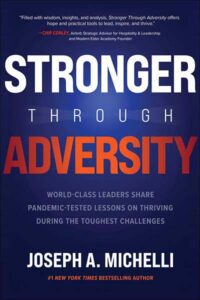
Stronger Through Adversity: World-Class Leaders Share Pandemic-Tested Lessons on Thriving during the Toughest Challenges
I was in Mexico City. Someone read a book of mine somewhere down the road years ago. They said, “You need to bring this guy in.” It wasn’t as though they did an open-source selection on who they wanted to bring it. They brought in the person who wrote the book that resonated with them. For me, it’s always been my calling card. My book has always been a giant version of my introduction to people and I don’t have to pay for it.
They bought my business card. It’s a wonderful thing for me. I love what I get to do from the perspective of an author because it’s this one cycle of working with companies, telling their story and having other companies want me to create a story for them. I can’t imagine a better business than what we do every single day.
Joseph, if we want to find you and talk to you a little bit more because our business needs some renovation in that area or some help, how do we find you?
Let me make sure I give free resources. If you go to LinkedIn and look at Joseph Michelli, I do a weekly newsletter that has these thoughts on it. You don’t have to pay me a dime to be able to get a weekly five tips on anything with an infographic. Joseph Michelli on LinkedIn. Follow me there or anywhere else. I’m shamelessly always the same @JosephMichelli on Twitter, JosephMichelli.com. If you can spell my name, you can find me and I’m sure we can connect.
For those of you who are not using the LinkedIn newsletter function, you’re missing out. We have been using it and we have 2,300 followers. We didn’t even know the impact it was having until we looked at somebody else’s and said, “They have that. We have this. How do we do that?”
Everyone can do it. There was a time when LinkedIn limited only a certain number of people doing newsletters. Now, if you know how to do it, anyone can access and start creating a newsletter. I strongly recommend it. One last tip on that, once you’ve created it, then try to move your newsletter followers on LinkedIn into your private newsletter so you have their emails and you can market to them as part of that relationship-building thing that we’re talking about.
I am so glad you said that because that’s one of the big things that authors miss when we work on platform building. They don’t understand that they don’t own their Facebook or Twitter. You’ve seen it on Twitter. You can say the wrong thing and be logged out in a minute or cancel. Even with Facebook, the algorithm changes. People have lost huge audiences that it took them years to tender and grow. That’s important what he said. You have to transition those people. We do it through our magazine, the Breakthrough Author Magazine. Joseph, thank you so much for joining us. I enjoyed this.
Thank you, Juliet. It was a pleasure. Much success to all who follow you. Thanks for what you do in our community.
Important Links
- Superbrand Publishing – YouTube
- www.BreakthroughAuthorMagazine.com
- Joseph Michelli
- Stronger Through Adversity
- LinkedIn – Joseph Michelli
- @JosephMichelli – Twitter
About Joseph Michelli
 Joseph Michelli, Ph.D., is a certified customer experience professional, the author of ten business books about companies like, The Ritz-Carlton Hotel Company, Mercedes-Benz, Starbucks, Zappos, and Airbnb. In addition to being a Wall Street Journal and New York Times #1 bestselling author, Joseph helps leaders and frontline team members improve the experiences they provide to colleagues and customers. Joseph is also an internationally sought-after keynote speaker on leadership and human experience design.
Joseph Michelli, Ph.D., is a certified customer experience professional, the author of ten business books about companies like, The Ritz-Carlton Hotel Company, Mercedes-Benz, Starbucks, Zappos, and Airbnb. In addition to being a Wall Street Journal and New York Times #1 bestselling author, Joseph helps leaders and frontline team members improve the experiences they provide to colleagues and customers. Joseph is also an internationally sought-after keynote speaker on leadership and human experience design.
Love the show? Subscribe, rate, review, and share!
Join the Promote, Profit, Publish Community today:

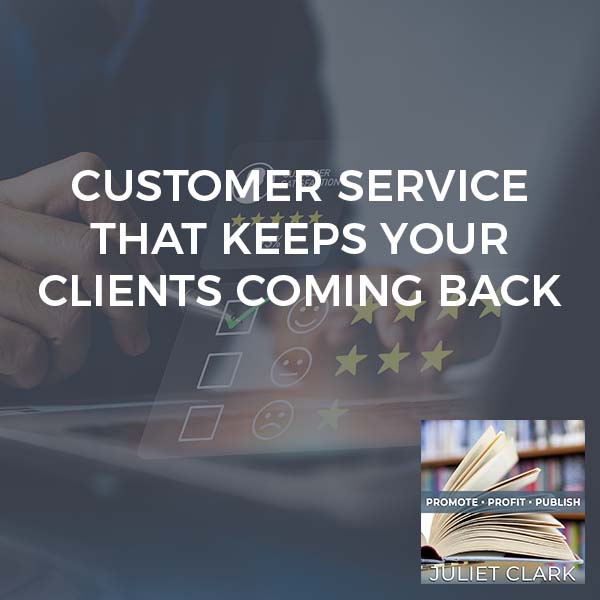


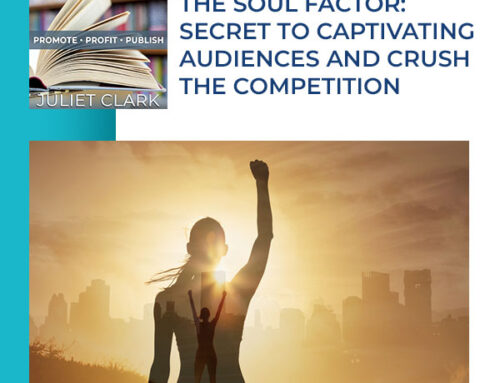
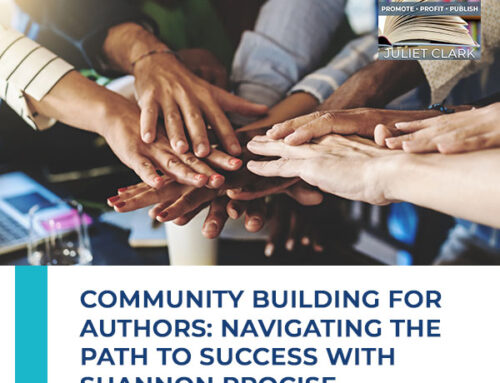



Leave A Comment